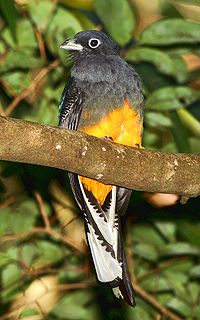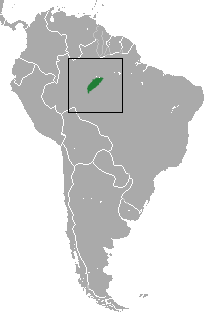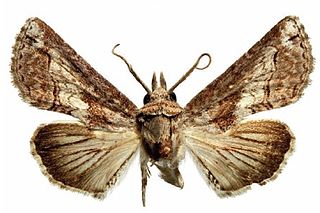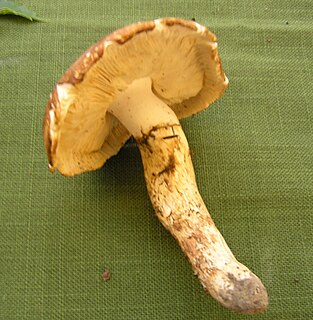Related Research Articles

The Pitheciidae are one of the five families of New World monkeys now recognised. Formerly, they were included in the family Atelidae. The family includes the titis, saki monkeys and uakaris. Most species are native to the Amazon region of Brazil, with some being found from Colombia in the north to Bolivia in the south.

The Guianan trogon, is a near passerine bird in the trogon family, Trogonidae. It is found in humid forests in the Amazon basin of South America and on the island of Trinidad. Until recently, this species, the gartered trogon of Mexico, Central America, and northern South America, and the Amazonian trogon of the western Amazon were all considered to be conspecific and collectively called violaceous trogon.

The titis, or titi monkeys, are the New World monkeys of the subfamily Callicebinae, which contains three extant genera, Cheracebus, Callicebus, and Plecturocebus. This subfamily also contains the extinct genera Xenothrix, Antillothrix, Paralouatta, Carlocebus, Lagonimico, and possibly also Tremacebus.

The white-tailed trogon is a near passerine bird in the trogon family. It is found in tropical humid forests of the Chocó, ranging from Panama, through western Colombia, to western Ecuador. It was formerly considered a subspecies of T. viridis, which is widespread in South America east of the Andes, but under the English name white-tailed trogon.

The chestnut-bellied titi is a species of titi, a type of New World monkey, endemic to Brazil. It was originally described as Callicebus caligatus in 1842.
Troglohyphantes is a genus of sheet weavers that was first described by G. Joseph in 1881. The genus name is a combination of the Ancient Greek τρώγλη (troglo-), meaning "cave (dweller)", and -hyphantes, a common ending for linyphiid genera.
Cohors prima Delmatarum milliaria equitata was a Roman auxiliary mixed infantry and cavalry regiment. It was named after, and originally recruited from, the Dalmatae, an Illyrian-speaking people that inhabited the Adriatic coastal mountain range of the eponymous Dalmatia.
Caligatus is a genus of moths of the family Euteliidae. The genus was erected by William Wing in 1850.

Euteliidae is a family of moths in the superfamily Noctuoidea. The family was erected by Augustus Radcliffe Grote in 1882.

Coleocentrus excitator is a parasitoid wasp in the family Ichneumonidae that parasitizes the long-horned beetle species Ergates faber.

Therates is a genus of beetles in the family Carabidae, containing the following species:

Tricholoma caligatum is a mushroom of the agaric genus Tricholoma. It is a large species with a distinct sheathing ring on the stem, found in mycorrhizal association with various trees throughout the Mediterranean. It is sometimes referred to as the European Matsutake, though it is certainly gastronomically inferior to the true Matsutake, a related species highly prized in Japan.
Dolichoderus feae is a species of ant in the genus Dolichoderus. Described by Emery in 1889, it is endemic to multiple countries, notably China, India, Myanmar (Burma) and Thailand.
Campodorus is a genus of parasitic wasps in the tribe Mesoleiini.
Violaceous trogon has been split into the following species:

Neuroleon is a large and complex genus of antlions in the subfamily Myrmeleontinae. There are more than 150 described species from Europe, Asia and Africa, and there are many undescribed taxa. Where the biology of the larvae is known, they live freely in sand or in sheltered rock crevices.

Plecturocebus is a genus of monkeys known as titis.
Coleocentrus is a genus of parasitoid wasp from the ichneumonid family.
References
| This Ichneumonidae-related article is a stub. You can help Wikipedia by expanding it. |